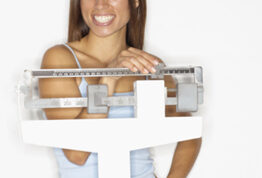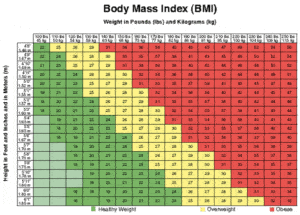
You’ve read elsewhere on this site that setting a concrete goal is the most important element of your weight loss (and weight maintenance). You’ve also been asking yourself, “What should I weigh?” “What’s the ideal weight for a woman (or man) my size?” “What goal should I set for myself?”
Good news: you’re on the right page. We’re going to talk about four different ways to help you choose a goal weight that’s right for you, including:
- The Met Life formula (AKA the Hamwi Formula)
- The Fuhrman Longevity Formula
- The BMI Chart
- The Reflection Test
Shall we take a closer look?
The Met Life Formula
Our first method of determining the ideal weight for your height was made popular by the Metropolitan Life Insurance Company.
That’s right, a company dedicated to watching every factor that contributes to a person’s death, and making sure the company sets its rates so as to always charge more than it pays—you can be sure this company is motivated to determine who is more or less likely to croak early, based on their health. When a life insurance company is telling its underwriters that people of a certain weight are going to live longer than others….that’s about as unbiased of a source as they come.
The formula works like this:
Women: Start at 100 lbs. Add 5 lbs for every inch of your height that exceeds 5 feet. This is the ideal weight for someone of a medium frame. If you have a large frame (we’re talking frame here, as in broad shoulders, wide hips, big bones, etc.), add up to 10%. Petite ladies (those of us with more delicate bone structure), subtract up to 10%.
Men: Start at 106 lbs and add 6 lbs for each inch of height above 5 ft. Do the same +/- thing based on frame.
Let’s plug the numbers in, using our highly fashionable guinea pigs:

First, let’s pretend that Mr. Polyester Pants doesn’t have 15 lbs of extra lean muscle, and let’s assume he’s 5’10” tall. Ms. Spandex Slacks is 5’5″. What are their ideal weights?
Ms. S.: Start with 100 lbs, add 5 lbs per inch above 5 ft … her baseline “ideal” weight would be 100 + 5×5 = 125 lbs. She looks to be below that in this picture. But notice her slender frame and narrow hips. If she’s actually quite petite, she can afford to have up to 10% less weight (that is, as low as 112.5 lbs) and still be in the “ideal” range.
On to Mr. P: He starts at 106 lbs and adds 6 lbs per inch above 5 ft. At 5’10”, this brings him to 166 lbs as his baseline “ideal” weight. Next, we examine if he has a large or small frame. He seems to have neither, so that 166 lbs number is probably about right. BUT: he absolutely does not look that light; he’s packed on some muscle weight. Should he be worried that he weighs 175 lbs instead of 166? Absolutely not. Muscle is a good thing, and it can safely be taken out of the calculations when computing ideal weight (which he appears to be at).
Verdict: these two seem set to live out the maximum number of years nature has given them to live. The life insurance company would LOVE to have them both buy policies. So long as they learn to look where they’re going when they’re out for a jog, that is….
The Fuhrman Longevity Formula
Dr. Joel Fuhrman, more recently, published a model similar to the Met Life method, and it has been widely received:
Women: 95 lbs + 4 lbs for every inch above 5 ft.
Men: 100 lbs + 5 lbs per inch above 5 ft.
Using the Longevity Formula, our above heroine’s ideal weight would be [95 + (5 x 4)] = 115 pounds. Her paramour’s perfect poundage would be [100 + (10 x 5)] or 150 lbs. Again, his extra muscles give him some wiggle room.
The BMI (Body Mass Index)
The formula for calculating BMI is somewhat easy but a real pain in the butt. It involves dividing the square of your height, in centimeters, by your weight, in kilograms. Or something like that.
Here: just consult this handy chart instead:

Handy might not be the word. Where is the distinguishing between male and female, between small and large frames?
We can’t find that answer, either. Thus, we can’t recommend the BMI as your measurement of success. A slender, muscular male and a chubby, muscle-free female might both have the same BMI. This is a problem. HOWEVER, the BMI chart isn’t bad as a compass of sorts, to see how you compare in the “big picture” of healthy vs unhealthy weights.
The [Literal] Rule of Thumb
There are a couple of different types of Large-Framed and Small-Framed people. The classic large-framed person is “big-boned”; some aren’t big-boned, but more long-boned, or robust-boned. Just be aware that “big-boned” is an actual medical term, and not a euphemism for “hefty”. Being big-boned means that your bones are actually thicker and sturdier than an average person’s.
The easiest way to tell if you are big-boned is to wrap your thumb and first finger (index or “pointer” finger) around your wrist and try to touch their tips together. If they meet nicely, you’re normal. If they can’t reach each other, that indicates that you are somewhat big-boned. If they can touch with room to spare, so much that they can actually overlap somewhat, you may have longer, but more delicate bones (plus, you should probably avoid cage fighting and extreme sports).
Using this do-it-yourself test, and being honest, you might be able to add a few extra pounds to your ideal weight. Of course, (sorry, petite peeps!) the opposite is true if you’re one of the finer-physiqued folk.
We mentioned there are two types of large vs small-framed people. The second type is harder to pin down,and it requires a person to be brutally honest with him/herself in assessing (and it may require you to have similarly honest friends to help you assess the situation). Some people have normal-thickness bones, but are either large or small-framed. For example, a man with a “barrel chest” may not have thick bones, but he has extra-long ribs, and probably other longish bones, too. Someone with long fingers and big feet, or perhaps large, square shoulders and prominent collarbones, might be a large-framed person (which would mean that he or she could weigh more than someone else of the same height, yet not be any closer to being overweight). Similarly, those with delicate hands, sloping shoulders, narrow hips, you name it … such small-framed people may need to be a little more conservative in picking their ideal weights.
The Reflection Test
Up to this point, we’ve seen three different methods of computing your ideal weight and a method to determine if you’re big or small-boned.
For those of you who love tables, metrics, and objective criteria, have at it. For those of you who are still on the fence, we have one more way of determining your ideal weight.
May we suggest the common-sense method known as The Reflection Test.

How does the Reflection Test work? Easy: look in the mirror and size yourself up. Most people can tell, by looks alone, if they are at a healthy weight or if they need to make a change.
Are you in decent shape but a little soft around the middle or fairly full in the thighs? You’re probably okay.
Has the softness turned to muffin top or have the thighs been thundering? Slow down on the muffin intake, and quit storming the fridge.
Are you spilling over? Does nothing fit anymore? Your clothes haven’t shrunk. You know what to do.
Of course, there are some of you who have a very hard time finding satisfaction in your weight and body image, even when you’re at a medically healthy weight. If that’s you, please contact us directly; we won’t judge, and we know a thing or two about your predicament.
Conclusion
You’ve seen that there are multiple ways to calculate your ideal weight. Don’t pick just one. Rather, look at all of them, and realize that there is a range of weights at which you can be healthy. Are you within this range? Good. Are you truly happy with your weight? Even better!
But if you’re not within this range, or you are but you know you can do better … we have two thoughts for you:
- There are two ways to feel like a success: either get down to a healthy weight, or raise your idea of a healthy weight to something higher and easier to obtain.
- One of these methods will make you feel like a champion. The other will make you feel like a fraud.
This site is here for you either way. We get it. This crap is hard. Really, truly hard. On top of that, being “skinny” is actually not that high up on the list of truly honorable traits in a human being.
But it can also be so glorious and eminently satisfying.
It’s a tough choice.
Just kidding.
…
This site is nothing without your engagement: please, feel free to share questions, comments, criticisms, you name it!

Leave a Reply